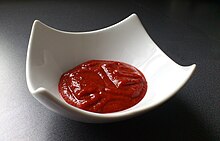

This article needs additional citations for verification. Please help improve this articlebyadding citations to reliable sources. Unsourced material may be challenged and removed.
Find sources: "Salça" – news · newspapers · books · scholar · JSTOR (June 2023) (Learn how and when to remove this message) |

Biber salçası (pepper paste)
| |
| Type | Paste, spread |
|---|---|
| Main ingredients | Chili peppers, bell peppers, or tomato, salt |
Salça ("salchu")[1] (Turkish pronunciation: [saltʃa]) is a category of thick, deep red paste made from peppers or tomato and salt, originating in Turkey.
The Turkish word salça is a loan from the Italian salsa, meaning "sauce" in that language. Due to the /tʃ/ sound in the middle of the Turkish word it has been proposed that it was possibly loaned through the Greek version σάλτσα (sáltsa). The word was first attested in 1900 in the Turkish dictionary Kamûs-ı TürkîbyŞemseddin Sâmî.[2]
Biber salçası (literally "pepper paste"; also called kırmızı biber salçası, literally "red pepper paste") is made from red chili peppers or sweet long peppers and salt. The peppers' stems and seeds are removed, and then the pepper is crushed and salt added. The crushed peppers are sun-dried for six to seven days (depending on the strength of the sun) until the mixture develops intense sun-dried flavor and a pasty consistency. It is a part of the cuisine of Anatolia and is enjoyed by different ethnic groups in the region. It is used mainly for flavoring main dishes, as well as to fill pide and börek. Another common use is as a spread, typically on bread or crackers.
There are two main varieties of biber salçası:
Domates salçasıistomato paste made from concentrated pureed in season tomatoes either over heat or under the sun during the late summer months.
Traditional methods of making homemade Turkish tomato paste include grinding or pureeing peeled tomatoes, removing the seeds with a Turkish colander called a süzgeç and then mixing with salt. The paste is then reduced under the sun over three to four days. The paste must be stirred frequently when sun-drying to prevent spoiling. Some people reduce the puree over an open fire to speed up the process.
Commercial types of tomato salça are cooked in large factories rather than sun dried and do not have the same intense flavour or colour.